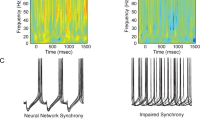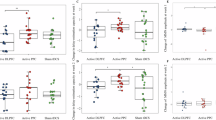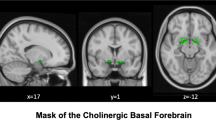Abstract
Schizophrenia patients perform poorly on cognitive control tasks and exhibit dysfunction in anterior cingulate cortex (ACC) and dorsolateral prefrontal cortex (DLPFC) during task performance. The unaffected relatives of patients with schizophrenia also exhibit poor cognitive control task performance. However, the relationship between these behavioral deficits in relatives and the integrity of ACC and DLPFC functioning is unclear. In the present study, we used the Stroop color-naming task and event-related fMRI to examine cognitive control task performance and associated neural activity in 17 unaffected relatives of schizophrenia patients and 17 demographically matched healthy controls. On the Stroop task, unaffected relatives exhibited intact post-conflict-related performance adjustments. fMRI data revealed that unaffected relatives exhibited reduced activity in DLPFC but they exhibited intact activity in ACC. These results suggest that DLPFC dysfunction may be related to the genetic risk for schizophrenia as both patients and their unaffected relatives show reduced activity in this region. In contrast, the current results suggest that ACC dysfunction in people with schizophrenia may reflect processes specific to the illness itself.
Similar content being viewed by others
Log in or create a free account to read this content
Gain free access to this article, as well as selected content from this journal and more on nature.com
or
References
Barch DM (2005). The cognitive neuroscience of schizophrenia. In: Cannon T, Mineka S (eds). Annual Review of Clinical Psychology, vol. 1 American Psychological Association: Washington, DC, pp 321–353.
Barch DM (2006). Introduction to special theme issue. Schizophr Bull 32: 486–488.
Botvinick MM, Braver TS, Barch DM, Carter CS, Cohen JD (2001). Conflict monitoring and cognitive control. Psychol Rev 108: 624–652.
Callicott JH, Bertolino A, Mattay VS, Langheim FJ, Duyn J, Coppola R et al (2000). Physiological dysfunction of the dorsolateral prefrontal cortex in schizophrenia revisited. Cereb Cortex 10: 1078–1092.
Callicott JH, Egan MF, Mattay VS, Bertolino A, Bone AD, Verchinksi B et al (2003a). Abnormal fMRI response of the dorsolateral prefrontal cortex in cognitively intact siblings of patients with schizophrenia. Am J Psychiatry 160: 709–719.
Callicott JH, Mattay VS, Verchinski BA, Marenco S, Egan MF, Weinberger DR (2003b). Complexity of prefrontal cortical dysfunction in schizophrenia: more than up or down. Am J Psychiatry 160: 2209–2215.
Carter CS, MacDonald III AW, Botvinick MM, Ross LL, Stenger VA, Noll D et al (2000). Parsing executive processes: strategic vs evaluative functions of the anterior cingulate cortex. Proc Natl Acd Sci USA 97: 1813–1817.
Carter CS, MacDonald III AW, Ross LL, Stenger VA (2001). Anterior cingulate cortex activity and impaired self-monitoring of performance in patients with schizophrenia: an event related fMRI study. Am J Psychiatry 158: 1423–1428.
Cohen JD, Botvinick M, Carter CS (2000). Anterior cingulate and prefrontal cortex: who's in control? Nat Neurosci 3: 421–423.
Cohen JD, Servan-Schreiber D (1992). Context, cortex, and dopamine: a connectionist approach to behavior and biology in schizophrenia. Psychol Rev 99: 45–77.
Cox RW (1996). AFNI: software for analysis and visualization of functional magnetic resonance neuroimages. Comput and Biomed Res 29: 162–173.
Docherty NM, Gordinier SW, Hall MJ, Dombrowski ME (2004). Referential communication disturbances in the speech of nonschizophrenic siblings of schizophrenia patients. J Abnorm Psychol 113: 399–405.
Evans AC, Collins DL, Mills SR, Brown ED, Kelly RL, Peters TM (1993). 3D statistical neuroanatomical models from 305 MRI volumes. Proc IEEE Nucl Sci Symp Med Imag Conf 3: 1813–1817.
First MB, Spitzer RL, Gibbon M, Williams JBW (1996). SCID-I/P, Version 2.0. Biometrics Research Department, New York State Psychiatric Institute: New York.
Fissell K, Tseytlin E, Cunningham D, Iyer K, Carter CS, Schneider W et al (2002). Fiswidgets: a graphical computing environment for neuroimaging analysis. Neuroinformatics 1: 111–125.
Forman SD, Cohen JD, Fitzgerald M, Eddy WF, Mintun MA, Noll DC (1995). Improved assessment of significant activation in functional magnetic resonance imaging (fMRI): use of a cluster-size threshold. Magn Reson Med 33: 636–647.
Goldberg TE, Weinberger DR (2004). Genes and the parsing of cognitive processes. Trends Cogn Sci 8: 325–335.
Gottesman II, Gould TD (2003). The endophenotype concept in psychiatry: etymology and strategic intentions. Am J Psychiatry 160: 636–645.
Kerns JG (2006). Schizotypy facets, cognitive control, and emotion. J Abnorm Psychol 115: 418–427.
Kerns JG, Cohen JD, MacDonald III AW, Cho RY, Stenger VA, Carter CS (2004). Anterior cingulate conflict monitoring and adjustments in control. Science 303: 1023–1026.
Kerns JG, Cohen JD, MacDonald III AW, Johnson MK, Stenger VA, Aizenstein H et al (2005). Decreased conflict- and error-related activity in the anterior cingulate cortex in subjects with schizophrenia. Am J Psychiatry 162: 1833–1839.
Keshevan MS, Diwadkar VA, Spencer SM, Harenski KA, Luna B, Sweeney JA (2002). A preliminary functional magnetic resonance imaging study in offspring of schizophrenic parents. Prog Neuropsychopharmacol Biol Psychiatry 26: 1143–1149.
MacDonald III AW, Becker TM, Carter CS (2006). Functional MRI study of cognitive control in the healthy relatives of schizophrenia patients. Biol Psychiatry 60: 1241–1249.
MacDonald III AW, Carter CS (2003). Event-related fMRI study of context processing in dorsolateral prefrontal cortex of patients with schizophrenia. J Abnorm Psychol 112: 689–697.
MacDonald III AW, Carter CS, Kerns JG, Ursu S, Barch DM, Holmes AJ et al (2005). Specificity of prefrontal dysfunction and context processing deficits to schizophrenia in never-medicated patients with first-episode psychosis. Am J Psychiatry 162: 475–484.
Manoach DS (2003). Prefrontal cortex dysfunction during working memory performance in schizophrenia: reconciling discrepant findings. Schizophr Res 60: 285–298.
Mayr U, Awh E, Laurey P (2003). Conflict adaptation effects in the absence of executive control. Nat Neurosci 6: 450–452.
Miller EK, Cohen JD (2001). An integrative theory of prefrontal cortex function. Annu Rev Neurosci 24: 167–202.
Pfohl B, Stagl D, Zimmerman M (1982). The Structured Interview for DSM-III Personality Disorders (SID-P). University of Iowa Department of Psychiatry: Iowa City, IA.
Rougier NP, Noelle DC, Braver TS, Cohen JD, O'Reilly RC (2005). Prefrontal cortex and flexible cognitive control: rules without symbols. Proc Natl Acad Sci USA 102: 7338–7343.
Snitz BE, MacDonald III AW, Cohen JD, Cho RY, Becker TM, Carter CS (2005). Lateral and medial hypofrontality in first-episode schizophrenia: functional activity in a medication-naïve state and effects of short-term atypical antipsychotic treatment. Am J Psychiatry 162: 2322–2329.
Spitzer RL, Williams JBW, Gibbon M, First MB (1990). Structured Clinical Interview for DSM-III-R-Non-patient Edition (SCID-NP, Version 1.0). American Psychiatric Press: Washington, DC.
Tan HY, Sust S, Buckholtz JW, Mattay VS, Meyer-Lindenberg A, Egan M et al (2006). Dysfunctional prefrontal regional specialization and compensation in schizophrenia. Am J Psychiatry 163: 1969–1977.
Thermenos HW, Seidman LJ, Breiter H, Goldstein JM, Goodman JM, Poldrack R et al (2004). Functional magnetic resonance imaging during auditory verbal working memory in nonpsychotic relatives of persons with schizophrenia: a pilot study. Biol Psychiatry 55: 490–500.
Whalley HC, Simonottom E, Flett S, Marshall I, Ebmeier KP, Owens DGC et al (2004). fMRI correlates of state and trait effects in subjects at genetically enhanced risk of schizophrenia. Brain 127: 478–490.
Woods RP, Grafton ST, Holmes CJ, Cherry SR, Mazziotta JC (1998). Automated image registration: I. General methods and intrasubject, intramodality validation. J Comput Assist Tomogr 22: 139–152.
Acknowledgements
We thank Melissa Johnson and Ryan Walter for their help with running the study as well as the staff of the UPMC Magnetic Resonance Research Center for their help with data collection. This study was supported by National Institutes of Health (NIH) Grants MH059883 and MH066629. Data from this study were presented at the Society for Neuroscience Annual Meeting, San Diego, CA, October, 2004.
Author information
Authors and Affiliations
Corresponding author
Additional information
DISCLOSURE/CONFLICT OF INTEREST
Theresa Becker, Dr John Kerns, Dr Angus MacDonald, and Dr Cameron Carter reported no financial interests or potential conflicts of interest.
Rights and permissions
About this article
Cite this article
Becker, T., Kerns, J., MacDonald, A. et al. Prefrontal Dysfunction in First-Degree Relatives of Schizophrenia Patients during a Stroop Task. Neuropsychopharmacol 33, 2619–2625 (2008). https://doi.org/10.1038/sj.npp.1301673
Received:
Revised:
Accepted:
Published:
Issue date:
DOI: https://doi.org/10.1038/sj.npp.1301673
Keywords
This article is cited by
-
A multimodal magnetoencephalography 7 T fMRI and 7 T proton MR spectroscopy study in first episode psychosis
npj Schizophrenia (2020)
-
Evaluation of fronto-striatal networks during cognitive control in unmedicated patients with schizophrenia and the effect of antipsychotic medication
npj Schizophrenia (2018)
-
The Impact of MIR137 on Dorsolateral Prefrontal–Hippocampal Functional Connectivity in Healthy Subjects
Neuropsychopharmacology (2014)
-
Altered Cerebral Response During Cognitive Control: A Potential Indicator of Genetic Liability for Schizophrenia
Neuropsychopharmacology (2013)
-
Cognitive Control Deficits in Schizophrenia: Mechanisms and Meaning
Neuropsychopharmacology (2011)



